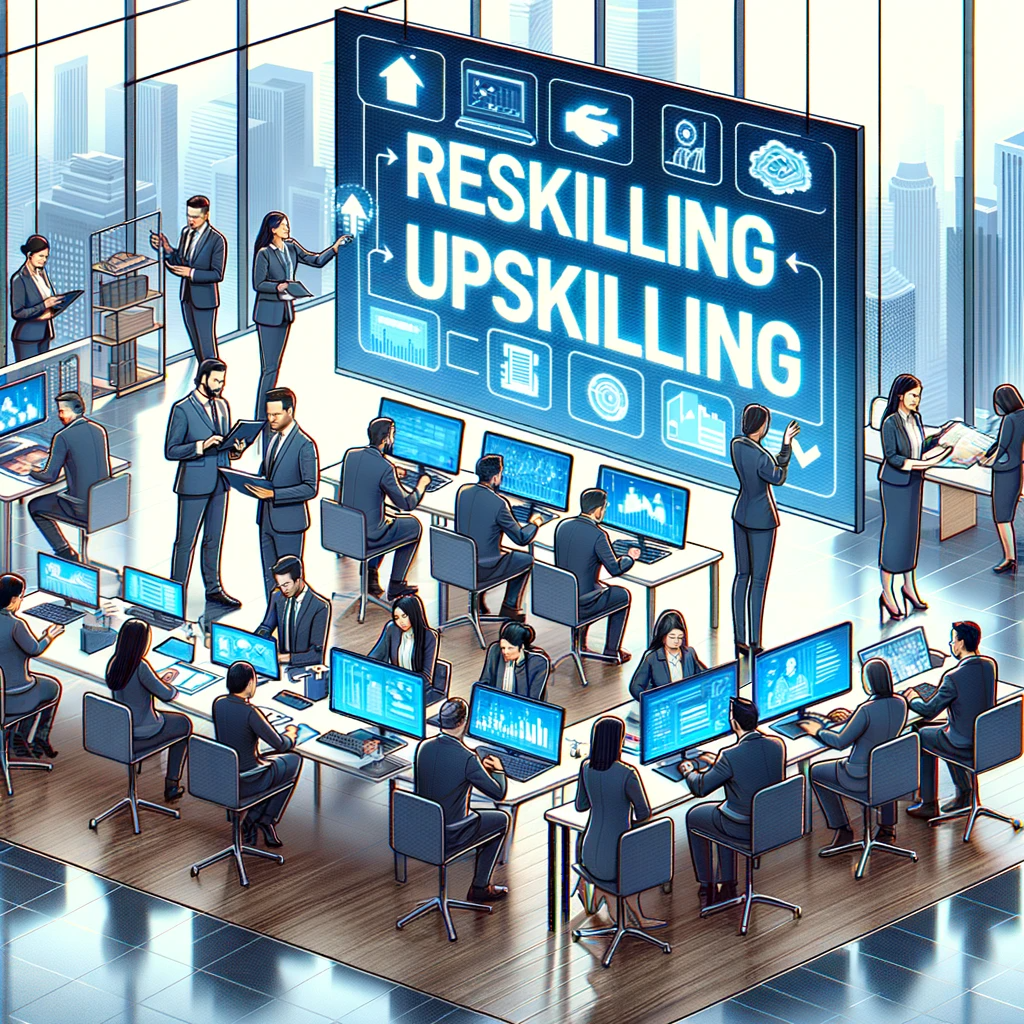Introduction
The business world is constantly evolving, driven by technological advancements and changes in the global economy. To stay competitive and adapt to these transformations, companies must invest in the development of their human resources. In this context, reskilling and upskilling emerge as fundamental strategies. In this article, we will delve into the benefits of implementing reskilling and upskilling in the company and how these practices can drive sustainable success.
Chapter 1: Understanding Reskilling and Upskilling
1.1 What is Reskilling?
Reskilling refers to the process of training employees to acquire new skills and knowledge, usually to take on roles different from those they previously held. This may be necessary due to automation, changes in market demand, or the adoption of new technologies.
1.2 What is Upskilling?
Upskilling is the process of enhancing employees’ existing skills to make them more competent and effective in their current roles. This can include the development of technical skills, leadership skills, communication skills, among others.
1.3 Differences between Reskilling and Upskilling
Reskilling focuses on acquiring new skills for different roles, while upskilling aims to strengthen existing skills for current roles. Both are crucial in today’s business environment.
Chapter 2: The Benefits of Reskilling and Upskilling
2.1 Improved Productivity
Reskilling and upskilling enable employees to be more competent and efficient in their roles, leading to higher productivity throughout the organization.
2.2 Higher Talent Retention
When companies invest in the professional development of their employees, they tend to feel more valued and committed, reducing turnover.
2.3 Adaptability to Changes
Rapid technological advancement and market changes require an adaptable workforce. Reskilling and upskilling prepare employees to embrace change and adapt to new circumstances.
2.4 Enhanced Innovation
Updated skills and fresh knowledge can lead to innovation in the company. Employees with improved skills are better equipped to find creative solutions to challenges.
2.5 Increased Competitiveness
Companies with highly skilled employees are more competitive in the market. This can result in higher revenue growth and a sustainable competitive advantage.
Chapter 3: Successful Implementation of Reskilling and Upskilling
3.1 Needs Assessment
Before starting reskilling and upskilling, it is crucial to conduct a needs assessment to identify areas where employees need development.
3.2 Customized Program Design
Each employee is unique, so reskilling and upskilling programs should be tailored to individual needs. This may include online training, on-the-job training, or in-person courses.
3.3 Continuous Evaluation
Employee progress must be continually assessed to ensure they are acquiring the necessary skills. This may include exams, feedback, and performance tracking.
3.4 Access to Learning Resources
Providing employees with access to learning resources, such as online libraries, online courses, and training materials, facilitates the reskilling and upskilling process.
3.5 Senior Management Support
Company leadership must actively support reskilling and upskilling efforts, setting a positive and committed tone throughout the organization.
Chapter 4: Reskilling and Upskilling in the Digital Age
4.1 Automation and Digitization
Automation and digitization are transforming the nature of work. Reskilling and upskilling are essential for employees to adapt to these new realities.
4.2 Digital Skills
The development of digital skills, such as programming, data analysis, and artificial intelligence, has become critical for almost every industry.
4.3 Online Learning
Online training has made reskilling and upskilling more accessible than ever. Online learning platforms offer courses on a wide range of topics.
Chapter 5: Success Stories
5.1 IBM
IBM has invested in reskilling and upskilling programs to train its workforce in digital skills, allowing them to adapt to the growing demand for technology.
5.2 Amazon
Amazon has launched the “Career Choice” program, offering its employees access to training in high-demand fields, regardless of whether those fields are related to their work at Amazon.
5.3 Google
Google has implemented the “Grow with Google” program, providing free online training in digital skills and technology, helping millions of people worldwide improve their skills.
Chapter 6: Challenges in Implementation
6.1 Resistance to Change
Some employees may resist reskilling and upskilling due to a fear of change or the perception of it being an additional burden.
6.2 Costs and Resources
Investing in reskilling and upskilling can be costly and require significant time and resources.
6.3 Staying Updated
Since technology and trends are constantly changing, keeping reskilling and upskilling programs up-to-date can be a challenge.
Chapter 7: The Future of Reskilling and Upskilling
7.1 Will Remain Fundamental
The pace of change in the business world suggests that reskilling and upskilling will continue to be crucial for adaptation and long-term success.
7.2 Focus on Transferable Skills
Transferable skills, such as problem-solving and creativity, will become increasingly important as job demands change.
7.3 Lifelong Learning
Lifelong learning will become the norm as people seek to stay relevant in their careers for decades.
Conclusions
The effective implementation of reskilling and upskilling in a company can have a significant impact on its sustainable success. From improving productivity and employee retention to staying updated with digitalization, the benefits are abundant. As companies face a constantly changing business environment, investment in workforce development becomes an essential strategy to stay competitive and prepared for the future.
Reskilling and upskilling are much more than mere skills investments; they are investments in the future and prosperity of the company and its employees. Continued commitment to training and skill development is the key to successfully navigating the ever-changing business landscape of the 21st century. Start implementing reskilling and upskilling in your company today and ensure a brighter future for all involved!
If you want to know how BLMS can help you with reskilling and upskilling in your company, please contact us.

